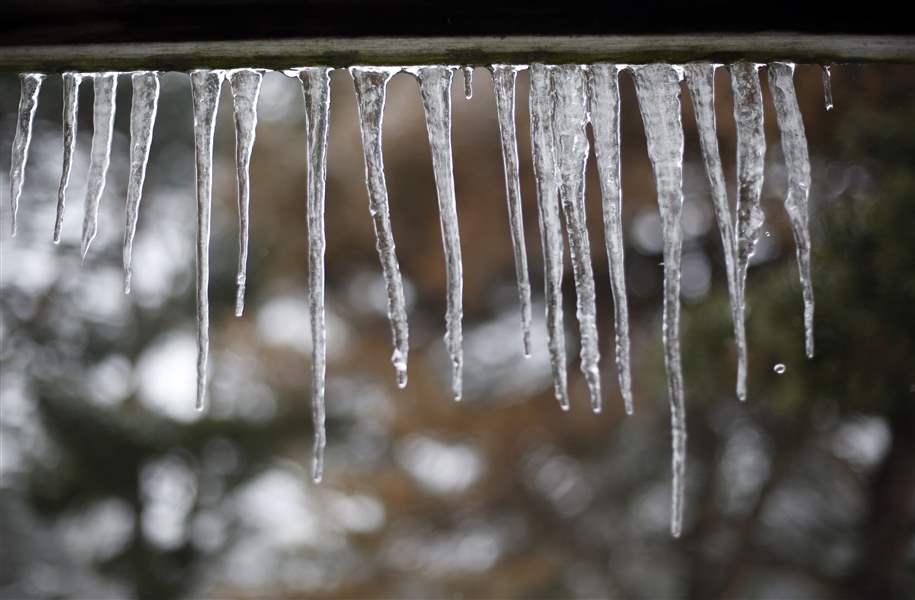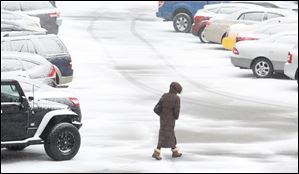
Brace yourselves: Old Man Winter to arrive in Toledo
12/5/2017
Icicles melt on the picnic shelter even though the snow continues to fall in Olander Park on March 3, 2016.
The Blade/Amy E. Voigt
Buy This Image

A pedestrian makes her way across a snow-covered parking lot on Orange Street Monday, March 13, 2017, in downtown Toledo.
Recent October-like conditions may have prompted Toledoans to keep out their warmer-weather clothing, but starting this week they’ll need to break out their heavy coats.
By Wednesday morning, weather forecasters said, it should feel more like January than early December — and it’s going to stay that way for a while.
No significant snowfall is predicted in Toledo for the immediate future, but Jay Berschback, chief meteorologist with WTVG-TV Channel 13, said areas far west and northwest of the city could get “lake-effect leftovers” from Lake Michigan during the next few days.
“Longer-term, we’re bound to get clipped by one of the storms passing by,” he said, “and any snow we get will stick around.”
With accumulating snow possible in the Snow Belt area farther east along the Lake Erie coast, the Ohio Highway Patrol issued an advisory to motorists about preparing both their vehicles and their driving habits to be winter-ready.
Lt. Shaun Robinson, commander of the patrol’s Toledo post, said motorists should be alert to slippery pavement even if no snow falls because an overnight frost can slicken bridges with “black ice.”
With cold air flowing both above them and beneath them, bridges freeze before other parts of a roadway that have still-warm soil beneath them.
And whenever the Toledo area gets its first accumulating snow, Lieutenant Robinson said, motorists need to watch not only the road but also other drivers.
“Especially during the first couple snowfalls,” accidents increase because drivers don’t slow down or aren’t paying attention, he said. “As the season progresses, people do adjust their driving habits.”
For now, it’s just going to be cold in the Toledo area, Mr. Berschback said, with a chance for a slight accumulation when a weak storm passes through during the weekend. Temperatures were expected to fall below freezing Tuesday night and stay there — even during the daytime — for quite a while.
“We have no big storms on the horizon for the next week,” the forecaster said, adding wind chills will get down into the single digits above zero.
Forecasting models show the frigid pattern lingering in the lower Great Lakes for several weeks at least, he said.
Crashes involving snowy, icy, or slushy roads increased by about 2,200, or 19 percent, to 13,783 last winter in Ohio compared to the previous winter, the patrol said.
Unsurprisingly, the patrol districts farthest north and with the largest populations accounted for the bulk of winter-related crashes. Its District 1, which includes Lucas, Wood, Hancock, and Hardin counties as well as counties west of those, was in third place with 1,642 crashes on snowy, icy, or slushy roads last winter.
The district including Cleveland topped the list.
Accident reports blamed 40 percent of Ohio’s winter-weather crashes a year ago on motorists’ “failure to control” and another 21 percent on speed.
“Drive slowly,” the patrol cautioned in its advisory. “Everything — accelerating, turning, braking — takes longer on snow-covered roads. Give yourself time to maneuver by slowing down.”
The patrol and the American Automobile Association both urged motorists to prepare vehicles beforehand by making sure they’re roadworthy and stocked with emergency supplies to protect against stranding during storms.
Batteries, tires, cooling systems, wipers, and defrosters should all be checked for proper function, the patrol said. The auto club also advised that people keep gas tanks at least half full at all times to prevent gas line freeze-ups, avoid using cruise control on slick roads, and only warm vehicles up outdoors to prevent carbon-monoxide poisoning from exhaust.
“If you really don’t have to go out [during a storm], don’t,” the auto club said. “Even if you can drive well in the snow, not everyone else can.”
Contact David Patch at dpatch@theblade.com or 419-724-6094.